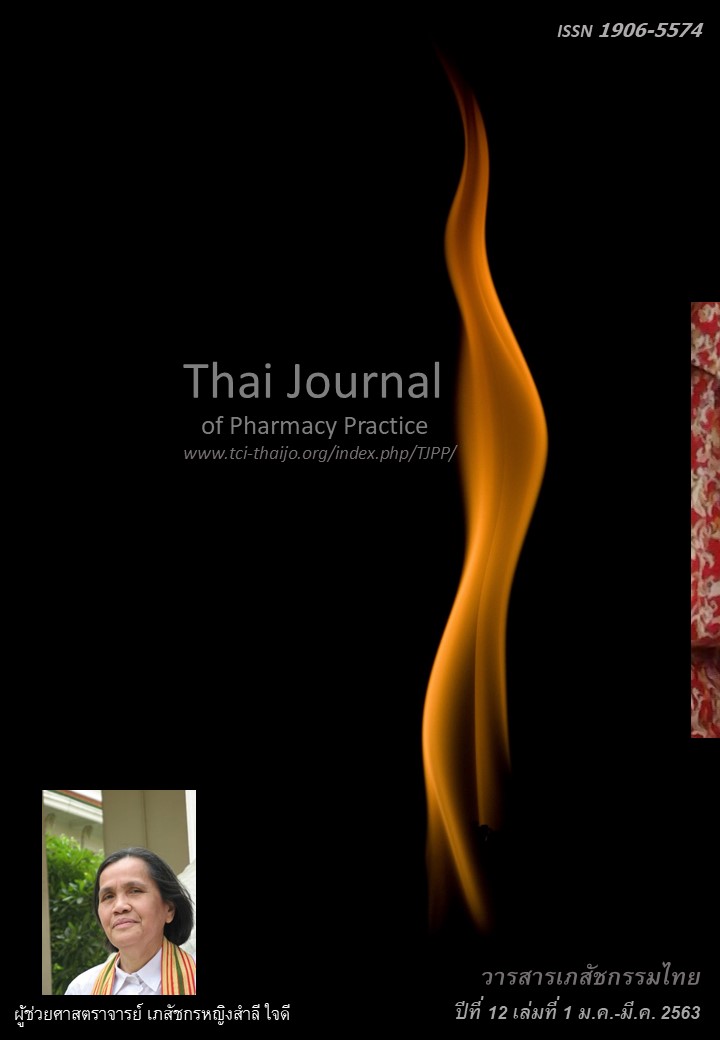การทดสอบแบบประเมินความแตกฉานด้านสุขภาพสำหรับชาวไทยชนิดรายการคำที่มีคำถามทดสอบความเข้าใจ (THLA-W+) ในประชาชนทั่วไป
Main Article Content
บทคัดย่อ
วัตถุประสงค์: เพื่อทดสอบความตรงและความเที่ยงของแบบประเมินความแตกฉานด้านสุขภาพสำหรับชาวไทยชนิดรายการคำที่มีคำถามทดสอบความเข้าใจหรือ Thai Health Literacy Assessment Using Word List with Extended Questions to Test Comprehension (THLA-W+) ในประชาชนทั่วไป และหาเกณฑ์คะแนน (cut-off) ที่ใช้แปลผลระดับความแตกฉานด้านสุขภาพ (health literacy: HL) วิธีการ: ผู้วิจัยทดสอบ THLA-W+ ในประชาชนบ้านคอเอน จังหวัดภูเก็ต จำนวน 522 คน แบบประเมินประกอบด้วยคำ 48 คำและมี 4 ตัวเลือกในแต่ละคำเพื่อทดสอบความเข้าใจในความหมายของคำ การคำนวณคะแนน THLA-W+ มี 3 วิธี คือ 1) คำนวณจากจำนวนคำที่อ่านถูกต้อง (THLA-W+R) 2) คำนวณจากการเลือกตัวเลือกถูกต้อง (THLA-W+C) และ 3) คำนวณจากจำนวนคำที่อ่านและเลือกตัวเลือกถูกต้องด้วย (THLA-W+RC) การทดสอบความเที่ยงใช้ค่าสัมประสิทธิ์ Cronbach’s alpha การทดสอบความตรงทำโดยหาความแตกต่างของคะแนน THLA-W+ ระหว่างผู้ที่มีระดับการศึกษาต่างกัน และหาค่าสหสัมพันธ์ระหว่าง THLA-W+ กับความสามารถในการอ่าน ความเข้าใจในเอกสารสุขภาพ การประเมินความสามารถในการอ่านเบื้องต้นของตนเอง คะแนนจากแบบคัดกรองผู้มี HL ไม่เพียงพอ และแบบวัด THLA-N8 (Thai Health Literacy Assessment: Nutrition Label) การทดสอบความสามารถของ THLA-W+ ในการทำนาย HL ใช้การวิเคราะห์ receiver operating curve ผลการวิจัย: คะแนนจากการคำนวณทั้ง 3 วิธีของ THLA-W+ มีค่าความเที่ยงเท่ากับ 0.80, 0.87 และ 0.87 ตามลำดับ และมีคะแนนเฉลี่ยเท่ากับ 45.57 ± 3.24, 31.58 ± 7.65 และ 30.59 ± 7.82 ตามลำดับ (จากคะแนนเต็ม 48 คะแนน) ตัวอย่างที่มีระดับการศึกษาสูงกว่ามีคะแนน THLA-W+ ที่มากกว่า ค่าสัมประสิทธิ์สหสัมพันธ์ (r) ของ THLA-W+ กับตัวชี้วัด HL ต่าง ๆ เป็นบวก (r = 0.129-0.371) และมีนัยสำคัญทางสถิติ (P<0.001) ค่า r ระหว่าง THLA-W+C กับ THLA-W+RC เท่ากับ 0.977 ค่าการทดสอบคุณสมบัติของ THLA-W+ เช่น ความไว ความจำเพาะ ความถูกต้อง (accuracy), positive predictive value (PPV), negative predictive value (NPV), likelihood ratios for positive test (LR+) และ likelihood ratios for negative test (LR-) ของ THLA-W+C และ THLA-W+RC มีค่าที่ดีกว่า THLA-W+R เกณฑ์การแปลผล THLA-W+C คือ ผู้ที่ได้คะแนน < 37 ถือว่ามี HL ที่ไม่เพียงพอ THLA-W+ สามารถแยกแยะผู้ที่มีระดับ HL ต่างกันได้ดี เมื่อใช้ความสามารถในการอ่านและความสามารถในการเข้าใจเอกสารสุขภาพเป็นตัวแปรมาตรฐาน THLA-W+C และ THLA-W+RC มีความไวร้อยละ 77-84 ความจำเพาะร้อยละ 81-83 พื้นที่ใต้โค้งที่ 0.86-0.87 ความถูกต้องในการทำนายคือ ร้อยละ 77-78 สรุป: การใช้แบบวัดนี้ควรคำนวณคะแนนแบบ THLA-W+C เนื่องจากสะดวกในการประเมินและให้คุณสมบัติที่ดีเหมือน THLA-W+RC แบบวัด THLA-W+C สามารถให้ข้อมูลที่สำคัญต่อการตัดสินใจในการปฏิบัติงานและเหมาะสมที่จะใช้สำรวจระดับ HL ในประชาชนทั่วไป
Article Details
ผลการวิจัยและความคิดเห็นที่ปรากฏในบทความถือเป็นความคิดเห็นและอยู่ในความรับผิดชอบของผู้นิพนธ์ มิใช่ความเห็นหรือความรับผิดชอบของกองบรรณาธิการ หรือคณะเภสัชศาสตร์ มหาวิทยาลัยสงขลานครินทร์ ทั้งนี้ไม่รวมความผิดพลาดอันเกิดจากการพิมพ์ บทความที่ได้รับการเผยแพร่โดยวารสารเภสัชกรรมไทยถือเป็นสิทธิ์ของวารสารฯ
เอกสารอ้างอิง
2. Health Education Division, Department of Health Service Support Ministry of Public Health. Guidelines for the development of health literacy to change behavior and reduce risk. Nonthaburi: Ministry of Public Health, 2013.
3. Berkman ND, Sheridan SL, Donahue KE, Halpern DJ, Viera A, Crotty K, et al. Health literacy inter- ventions and outcomes: an updated systematic review. Evidence Report/Technology Assesment No. 199. Rockville, MD. Agency for Healthcare Research and Quality; 2011.
4. Davis TC, Crouch M, Wills G, Abdehou D. Rapid assessment of literacy levels of adult primary care patients. Fam Med 1991; 23: 433-55.
5. Parker RM, Baker DW, Williams MV, Nurss JR. The test of functional health literacy in adults: a new instrument for measuring patients’ literacy skills. J Gen Intern Med 1995; 10: 537-41.
6. Weiss BD, Mays MZ, Martz W, Casto KM, DeWalt DA, Pignone MP, et al. Quick assessment of literacy in primary care: the newest vital sign. Ann Fam Med 2005; 3: 514-22.
7. Jindawong B. Validity and reliability of the Thai version of health literacy screening tools for patients at Srinagarind Hospital, Khon Kaen, Thai- land. [master thesis]. Khon Kaen: Khon Kaen Uni- versity; 2013.
8. Phantong W. Development of the Thai Health Literacy Assessment using Word List (THLA-W). [master thesis]. Songkla: Prince of Songkla Univer- sity ; 2016.
9. Chanchuto P. Development of the Thai Health Literacy Assessment Using Word List with Extended Questions to Test Comprehension (THLA -W+): testing in Sadao Hospital. [master thesis]. Songkla: Prince of Songkla University; 2017.
10. Lee SY, Bender DE, Ruiz RE, Cho YI. Development of an easy-to-use Spanish health literacy test. Health Serv Res 2006; 41: 1392-412.
11. Faul GF, Erdfelder E, Buchner A and Lang AG. Statistical power analyses using G*Power 3.1: Tests for correlation and regression analyses. Behav Res Methods 2009; 41:1149-60.
12. Chew LD, Bradley K A, Boyko EJ. Brief questions to identify patients with inadequate health literacy. Fam Med 2004; 36: 588–94.
13. Na Phatthalung P, Lerkiatbundit S. Development of Thai health literacy assessment based on the assessment of ability to use nutrition label. Thai Journal of Pharmacy Practice 2019; 11: 659-77.
14. Cortina JM. What is coefficient alpha? An exami nation of theory and applications. J Appl Psychol 1993; 78: 98-104.
15. Hinkle DE, Wiersma W, Jurs SG. Applied statistics for the behavioral sciences. 5th ed. Boston: Hough- ton Mifflin; 2003.
16. Youden WJ. Index for rating diagnostic tests. Cancer 1950; 3: 32–5.
17. Zhou XH, Obuchowski NA, Obushcowski DM. Statistical methods in diagnostic medicine. New York: Wiley & Sons; 2002
18. Swets JA. Measuring the accuracy of diagnostic systems. Science 1988; 240:1285-93.
19. Jaeschke R, Guyatt GH, Sackett DL. Users' guides to the medical literature. III. How to use an article about a diagnostic test. B. What are the results and will they help me in caring for my patients? The Evidence-Based Medicine Working Group. JAMA. 1994; 271: 703-7.


